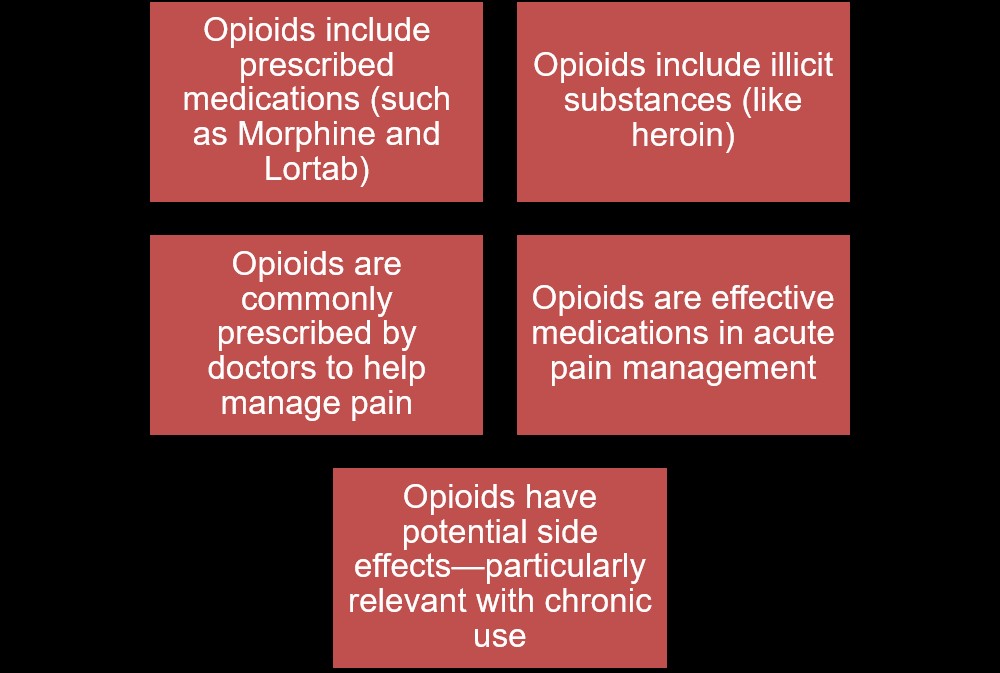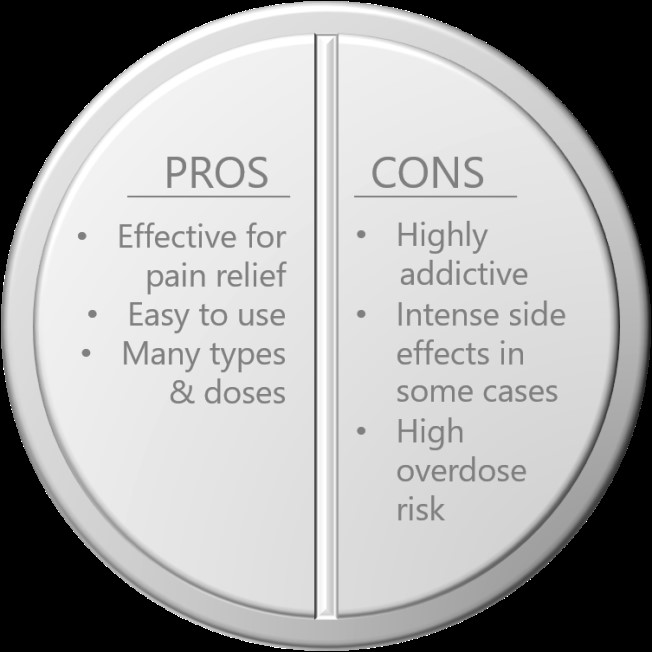Evidence-Based Alternative Pain Management Techniques for Chronic Pain

What is Chronic Pain?
Pain is one way our bodies let us know that something is wrong. It alerts us if we have been injured, or if our bodies need care. Most pain is short-lived or “acute,” and subsides with minimal effort—but pain that lasts longer or doesn’t go away as quickly is known as “chronic” pain and can persist for months or even years. Sometimes the pain of a past injury can remain, but other times pain can persist even without prior injury (National Institute of Neurological Disorders and Stroke, 2019). The good news is if you or a loved one experiences chronic pain, there are many options available that can lead to lasting relief. This fact sheet will review and explain some of the most successful evidence-based non-opioid methods to manage chronic pain as identified through rigorous research (e.g., Turk, et al., 2011).

Opioids for Pain Management
Opioids are a common type of drug prescribed by providers for pain management. They are a synthetic drug made or derived from the opium plant and are a central nervous system depressant, which can reduce the perception of pain and cause drowsiness (Centers for Disease Control and Prevention [CDC], 2018; Nabipour, et al., 2014).

Figure 1. Opioid Quick facts
Side-effects are common with pharmaceutical-based treatments. Use of opioids may generate:
- Immunosuppression (weakened immune system)
- Change hormones (i.e. testosterone, estrogen & others)
- Initiate depressive symptoms Induce Hyperalgesia (increasing pain sensitivity)
- Sedation and/or abnormal sleep habits
- Bladder dysfunction and constipation
- In rare cases, cardiac issues, or death
(Buenadventura, et al., 2008)
As such, opioids may not be the best option for patients seeking cost-effective, long-term treatment (Gatchel, et al., 2014). Opioids, including prescriptions, are extremely addictive in nature. If opioids are not used as prescribed, they could lead to a dangerous overdose. According to the Center for Disease Control and Prevention (CDC) over 70,000 people died of an overdose in 2017 in the United States, almost 70% of these overdoses involved an opioid (Scholl, et al., 2019). In addition, commonly-prescribed opioid medications alone are generally not enough to impact or improve physical and emotional function of most patients suffering from chronic pain (Turk, et al., 2011). Figure 2summarizes the pros and cons of opioids, and why they are likely not the best choice for long-term pain management.

Figure 2. Pros and Cons of Opioid Usage for Pain
The Evidence for Alternative Pain Management
With these concerns in mind, many have wondered if there are other effective options for pain management. For years, medical options like surgery or opioid medications seemed to be the only options, but steady research has uncovered many alternative techniques that can effectively relieve or reduce pain. Alternative techniques for pain management are highly sought after—but not all are evidence based. To be considered. evidence based, the practice must be rooted in the best current evidence and demonstrate improvement in the care quality of individual patients (Sackett, et al., 1996). Although we will not address all evidence-based and emerging methods in this fact sheet, we will discuss four evidence-based options that have been identified by researchers at Mayo Clinic (Hooten, 2016; Nahin, et al., 2016) as being generally effective and widely available:
- Cognitive Behavioral Therapy (CBT) for Chronic Pain
- Acceptance and Commitment Therapy (ACT)
- Yoga/Tai Chi
- Mindfulness
For the purposes of this fact sheet, we will be focusing on the four options listed. Other evidence-based options include Physical Therapy, Acupuncture, and some minimally-invasive medical procedures, which one can explore outside of this sheet (Practice Guidelines for Chronic Pain Management, 2010).
Cognitive Behavioral Therapy (CBT):
CBT is a structured approach delivered by a licensed mental health professional (e.g. psychologist, social worker, etc.) to help patients understand the thoughts, feelings, and impulses that lead to their behaviors—and restructure or replace them as needed to improve thinking or behavior patterns (Gatchel, et al., 2014). CBT for chronic pain improves overall daily functioning and quality of life for a variety of chronic pain conditions (Morley, et al., 1999). If CBT-CP training isn’t locally available, technology-based delivery of this type of self-management therapy for chronic pain has been proven effective (Guarino, et al., 2018). Even online CBT when combined with standard medical/medication treatment improves pain management significantly (Guarino, et al., 2018).
Though CBT does not reduce overall pain severity, pain is reduced more quickly than with standard treatment. CBT has been shown to lower distressing thoughts about pain, decrease negative substance-related behaviors, and even lower pain-related emergency department visits (Guarino, et al., 2018). With these evidence-based impacts in mind, persons undergoing pain treatment may consider CBT for their chronic pain.
Acceptance and Commitment Therapy:
Acceptance and Commitment Therapy (ACT) is a form of therapy that seeks to help individuals live a meaningful life – all while accepting the inevitable pains that life brings (Harris, 2006). Unlike CBT that strives to change thought patterns as needed, mindfulness-based practices like ACT aim to establish acceptance of one's thoughts and feelings as a health tool (Pollak, et al., 2014). Notably, this approach can be beneficial for acute and even chronic pain management (Vowles, et al., 2019). In a recent study, researchers noted that participants who were given a one-day ACT workshop post-surgery required fewer opioids for pain relief than participants who received treatment as normal (Dindo, et al., 2018). ACT for chronic pain is based on the idea that by learning to live with and accept chronic pain, people can control the grasp that pain has over their life (Foreman & Kaye, 2016). It is possible that in using ACT and its tools to cope with pain, one may lead a more fulfilling life.
Yoga and Tai Chi:
Yoga is a type of mind–body meditation practice that began centuries ago in India (Basavaraddi, 2015). It has been shown to reduce perceived anxiety and stress while also improving mental and physical health (Saoji, 2016). Yoga focuses on breathing, poses, personal discipline, concentration, mindful awareness, meditation, and stillness (Chang, et al., 2016). In one of the earliest studies conducted about the impacts of yoga on chronic pain, Williams and colleagues (2005) first evaluated clinical pain levels of participants, along with their pain-related fears and beliefs about pain. They then introduced yoga to these participants, and the yoga intervention showed an overall reduction in medication usage. Their study showed that pain reduction with yoga was two times greater than the educational control group (Williams, et al., 2005). Similar to yoga in some ways, tai chi originated in China, with an emphasis on movement and fluidity of mind/body connections (Lam, 2018). After comparing tai chi to other traditional interventions, tai chi demonstrated some of the highest gains in relieving chronic pain (Kong, et al., 2016). Though more research is needed about the definitive place of yoga and tai chi in pain management, they are emerging as evidence-based techniques to aid in pain relief.
Yoga and tai chi should be considered for pain management as they require little to no equipment and are generally more cost-effective treatments than other medical interventions. Though it is best to seek classes taught locally (so proper instruction can be given), yoga/tai chi can be done in the comfort of your own home with the help of pre-recorded videos and online-streaming.*
Mindfulness:
Another technique emerging as an evidence-based technique is mindfulness, which seeks to calm and soothe the mind by emphasizing conscious awareness of the present moment (Harris, 2006; Voss, et al., 2019). There are many types of mindfulness techniques and activities that can be taught by a broad range of trained instructors and mental health professionals. Mindfulness is central to ACT, and is often practiced with yoga and tai chi, but can be practiced alone through mindfulness meditation techniques. In combination with other forms of alternative pain management and even by itself, mindfulness can have a positive impact on reducing chronic pain (Veehof, et al., 2016). Recent studies have shown that mindfulness may reduce pain intensity, resulting from the way mindfulness skills influence the brain. Some individuals may even find that their pain experiences become more tolerable as a result of developing mindfulness skills and applying them long-term (Veehof, et al., 2016). More research is needed on the effectiveness of mindfulness, but it is a technique that can be considered by those looking to improve their pain management.
Summary:
There are many available therapies for pain relief. Pain management is not one-size-fits all, it is unique-- just like we all are!
We have highlighted a few here as a starting place to find what works for you. For a summary of the techniques discussed, please refer to Figure 3 below.
Figure 3. The Four Alternative Pain Management Techniques and Resulting Effects as Compared to Opioids
Where Can I Learn More?**
| Websites |
|
American Pain Society—americanpainsociety.org/ |
|
American Psychological Association—apa.org/helpcenter/pain-management |
|
National Center for Complementary and Integrative Health—nccih.nih.gov/health/pain/chronic.htm |
|
Utah State University Extension—digitalcommons.usu.edu/extension_curall/2000 |
| Books |
|
The Mindfulness Solution to Pain: Step-by-Step Techniques for Chronic Pain Management by Jackie Gardner-Nix |
|
Living Beyond Your Pain: Using Acceptance and Commitment Therapy to Ease Chronic Painby JoAnne Dahl, PhD & Tobias Lundgren, MS |
|
Yoga for Pain Relief: A New Approach to an Old Practice by Lee Albert, NMT |
| Programs |
|
Living Well with Chronic Pain –find a program near you: livingwell.utah.gov |
**Please note that all of the resources provided are for educational purposes and USU does not specifically endorse their services. The above resources are intended to provide information, not to treat chronic pain or other mental health concerns. USU does not control the websites or books referenced above.
References
- Basavaraddi, I. V. (2015). Yoga: Its Origin, History and Development. Ministry of External Affairs, Government of India. Retrieved from https://www.mea.gov.in/in-focus-article.htm?25096/Yoga+Its+Origin+History+and+Development
- Buenadventura, R. M., Adlaka, R. M., & Sehgal, N. M. (2008). Opioid complications and side effects. Pain physician, 11, S105-S120.Centers for Disease Control and Prevention. (2018, December 19). Opioid basics. https://www.cdc.gov/drugoverdose/opioids/index.html
- Chang, D. G., Holt, J. A., Sklar, M., & Groessl, E. J. (2016). Yoga as a treatment for chronic low back pain: A systematic review of the literature. Journal of Orthopedics & Rheumatology, 3(1), 1–8.
- Dindo, Lilian; Zimmerman, M. Bridget; Hadlandsmyth, Katherine; StMarie, Barbara; Embree, Jennie; Marchman, James; Tripp-Reimer, Toni; Rakel, Barbara. (2018). “Acceptance and Commitment Therapy for Prevention of Chronic Postsurgical Pain and Opioid Use in At-Risk Veterans: A Pilot Randomized Controlled Study.” The Journal of Pain, vol. 19, no. 10, Oct. 2018, pp. 1211–1221., doi:10.1016/j.jpain.2018.04.016.
- Foreman, Evan, and Joanna Kaye. “Treatment: Acceptance and Commitment Therapy for Chronic Pain.” Society of Clinical Psychology, DIVISION 12 OF THE AMERICAN PSYCHOLOGICAL ASSOCIATION, 2016, https://www.div12.org/treatment/acceptance-and-commitment-therapy-for-chronic-pain/.
- Gatchel, R. J., McGeary, D. A., McGeary, C. A., & Lippe, B. (2014). Interdisciplinary Chronic Pain Management. American Psychologist, 69(2), 119–130. doi: 10.1037/a0035514
- Guarino, H., Fong, C., Marsch, L. A., Acosta, M. C., Syckes, C., Moore, S. K., Cruciani, R. A., Portenoy, R. K., Dennis C Turk, D. C., Rosenblum, A. (2018). Web-Based Cognitive Behavior Therapy for Chronic Pain Patients with Aberrant Drug-Related Behavior: Outcomes from a Randomized Controlled Trial. Pain Medicine,19(12), 2423-2437. doi:10.1093/pm/pnx334
- Harris, Russell. “Embracing Your Demons: An Overview of Acceptance and Commitment Therapy.” Psychotherapy in Australia
- Hooten, W. M. (2016). Chronic Pain and Mental Health Disorders: Shared Neural Mechanisms, Epidemiology, and Treatment. Mayo Clinic Proceedings, 91(7), 955–970. doi: https://doi.org/10.1016/j.mayocp.2016.04.029
- Kong, L. J., Lauche, R., Klose, P., Bu, J. H., Yang, X. C., Guo, C. Q., . . . Cheng, Y. W. (2016). Tai Chi for Chronic Pain Conditions: A Systematic Review and Meta-analysis of Randomized Controlled Trials. Scientific Reports,6(1). doi:10.1038/srep25325
- Lam, P. (2018, April 13). History of Tai Chi. Tai Chi for Health Institute. Retrieved from https://taichiforhealthinstitute.org/history-of-tai -chi-2/
- Morley, S., Eccleston, C., & Williams, A. (1999). Systematic review and meta-analysis of randomized controlled trials of cognitive behaviour therapy and behaviour therapy for chronic pain in adults, excluding headache. Pain,80 (1), 1-13. doi:10.1016/s0304-3959(98)00255-3
- Murphy, J.L., McKellar, J.D., Raffa, S.D., Clark, M.E., Kerns, R.D., & Karlin, B.E. (2014). Cognitive Behavioral Therapy for Chronic Pain Among Veterans: Therapist Manual. Washington, DC: U.S. Department of Veterans Affairs.
- Nabipour, S., Ayu Said, M., & Hussain Habil, M. (2014). Burden and nutritional deficiencies in opiate addiction- systematic review article. Iranian Journal of P{ublic health, 43(8), 1022–1032.
- Nahin, R. L., Boineau, R., Khalsa, P. S., Stussman, B. J., & Weber, W. J. (2016). Evidence-Based Evaluation of Complementary Health Approaches for Pain Management in the United States. Mayo Clinic Proceedings, 91(9), 1292–1306. doi: 10.1016/j.mayocp.2016.06.007
- National Institute of Neurological Disorders and Stroke. (2019, March 27). Retrieved November 6, 2019, from https://www.ninds.nih.gov/Disorders/All-Disorders/Chronic-pain-Information-Page.
- Pollak, S. M., Pedulla, T., & Siegel, R. D. (2014). Three Ways to Bring Mindfulness into Therapy. Greater Good Science Center at UC Berkeley. Retrieved from https://greatergood.berkeley.edu/article/item/three_ways_bring_mindfulness_therapy
- Practice Guidelines for Chronic Pain Management: An Updated Report by the Anesthesiologists Task Force on Chronic Pain Management and the American Society of Regional Anesthesia and American Society of Anesthesia and Pain Medicine (2010). Anesthesiology, 112(4), 810–833. doi: 10.1097/aln.0b013e3181c43103
- Sackett, D. L., Rosenberg, W. M., Gray, J. A., Haynes, R. B., & Richardson, W. S. (1996). Evidence based medicine: What it is and what it isn’t. BMJ,312(7023), 71-72. doi:10.1136/bmj.312.7023.71
- Saoji, A. (2016). Yoga: A Strategy to Cope Up Stress and Enhance Wellbeing Among Medical Students. North American Journal of Medical Sciences,8(4), 200. doi:10.4103/1947-2714.179962
- Scholl, L., Seth, P., Kariisa, M., Wilson, N., & Baldwin, G. (2019). Drug and opioid-involved overdose deaths—United States, 2013–2017.Morbidity and Mortality Weekly Report, 67(5152), 1419.
- Turk, D. C., Wilson, H. D., & Cahana, A. (2011). Treatment of Chronic Non-cancer Pain. The Lancet, 377(9784), 2226–2235. doi: 10.1016/s0140-6736(11)60402-9
- Veehof, M. M., Trompetter, H. R., Bohlmeijer, E. T., & Schreurs, K. M. G. (2016). Acceptance- and mindfulness-based interventions for the treatment of chronic pain: a meta-analytic review. Cognitive Behaviour Therapy, 45(1), 5–31. doi: 10.1080/16506073.2015.1098724
- Voss, Maren Wright; Atisme, Kandice; Yaugher, Ashley; and Sulzer, Sandra H., "Mindfulness for Chronic Pain Management" (2019). All Current Publications. Paper 2000.https://digitalcommons.usu.edu/extension_curall/2000
- Vowles, Kevin; Sowden, Gail; Hickman, Jayne; Ashworth, Julie. (2019). “An Analysis of Within-Treatment Change Trajectories in Valued Activity in Relation to Treatment Outcomes Following Interdisciplinary Acceptance and Commitment Therapy for Adults with Chronic Pain.” Behaviour Research and Therapy, vol. 115, Apr. 2019, pp. 46–54., doi:10.1016/j.brat.2018.10.012.
- Williams, K. A., Petronis, J., Smith, D., Goodrich, D., Wu, J., Ravi, N., . . . Steinberg, L. (2005, May). Effect of Iyengar Yoga Therapy for Chronic Low Back Pain. Pain, 115(1-2):107-17. doi: 10.1016/j.pain.2005.02.016. https://www.ncbi.nlm.nih.gov/pubmed/15836974
Authors
Alise Williams Condie, Opioid Education Intern; Kira Swensen, Assistant County Extension Agent, Texas A&M
Related Research





